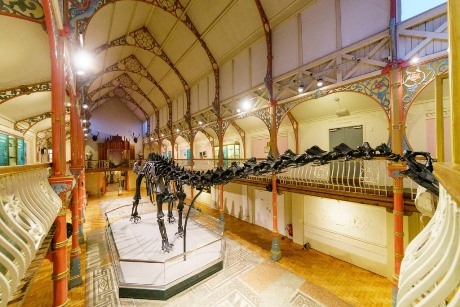Once the centre piece at London’s Natural History Museum, Dippy, a huge diplodocus skeleton, is currently visiting venues across the UK.

Once the centre piece at London’s Natural History Museum, Dippy, a huge diplodocus skeleton, is currently visiting venues across the UK.
Offering schools the chance to visit this Prehistoric artefact, the tour will be visiting Scotland, Ireland and Wales and five English regions until 2020.
Dippy is currently residing at the Dorset County Museum, where he will stay until 7th May.
Where will Dippy go next?
Following on from his stay in Dorset, Dippy will go on to visit Birmingham Museum and Art Gallery from 26th May until 9th September.
He will then visit the following:
Ulster Museum: 28th September 2018 – 6th January 2019
Kelvingrove Art Gallery and Museum, Glasgow: 22nd January – 5th May 2019
Great North Museum: Hancock, Newcastle upon Tyne: 18th May – 6th October 2019
National Assembly for Wales: 19th October 2019 – 26th January 2020
Number One Riverside, Rochdale: 10th February – 28th June 2020
Norwich Cathedral: 11th July – 31st October 2020

Pictured: Map of locations on Dippy’s tour.
What can the travelling exhibition teach students?
School groups visiting the Dippy exhibition wherever it travels can learn about the type of dinosaur he was and how he adapted and survived.
The exhibition will offer something different depending on its location. Currently, the display in Dorset coincides with an art exhibition which explores four artist’s works depicting the natural world and Prehistoric animals. The Dorset museum is also encouraging schools to take part in the Dippy Audio Trail which looks at different objects in the exhibition.
Each venue will be using Dippy’s skeleton to showcase local nature and natural history collections, partnering with cultural, scientific and wildlife organisations.
The tour will explore sustainability and biodiversity, which ties in with topics studied on the Science and Geography curriculum.
Teachers should keep an eye out for each individual museum taking part for details of each exhibition and what it will include.
Online resources are available with the Natural History Museum for Key Stage 1 and 2 pupils that can be used on a visit or even in the classroom, following Dippy on his tour with videos and information.
About Dippy
The full skeleton (in its displayed pose) is 26 metres long, 4.3 metres wide and 4.17 metres high. Conservators have taken the past 12 months to prepare the delicate plaster-of-Paris cast for its journey.
Dippy was a herbivore and lived between 145 and 156 million years ago during the late Jurassic period.
Never fear…
Visitors to the Natural History Museum will not be disappointed despite Dippy no longer being there. As Dippy left, Hope, the skeleton of a blue whale, took centre stage. School groups can now learn all about whales in an exhibition there which looks at what can be done to protect whales from extinction.
For more information regarding Dippy’s tour visit www.nhm.ac.uk.
Images: Copyright - Trustees of the Natural History Museum, London [2018]. All rights reserved










